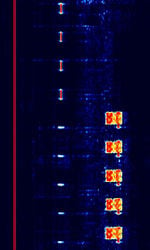CHU
CHU is a time signal radio station operated by the Institute for National Measurement Standards of the National Research Council of Canada.
This signal is broadcast on three frequencies: 3 kW (3330, 14670 kHzKiloHertz (kHz) 10^3 Hz) and 5 kW (7850 kHzKiloHertz (kHz) 10^3 Hz). The transmitter is located just south of Ottawa, Canada. The signal follows a strict pattern of CWContinuous Wave beeps, along with 9 seconds where a digital time code is transmitted in a 300 BdBaud (unit symbol Bd) is the unit for symbol rate or modulation rate in symbols per second. FSKFrequency-Shift Keying mode using the Bell 103 standard, a 2225 HzHertz (Hz), unit of frequency, defined as one cycle per second (1 Hz). tone to represent a mark (1 bit) and 2025 HzHertz (Hz), unit of frequency, defined as one cycle per second (1 Hz). tone for a space (0 bit).
Time Signal Format[edit]
Information taken from Wikipedia.
The primary time signal is a series of 300 msmilliseconds (.001 of a second) 1000 HzHertz (Hz), unit of frequency, defined as one cycle per second (1 Hz). tones, transmitted once per second, on the second. The following exceptions to the pattern provide additional information:
- The top of the minute is marked by a half-second-long beep.
- The top of the hour is marked with a one-second-long beep, followed by nine seconds of silence.
- The 29th second of a minute is always omitted (no beep).
- Between one and sixteen seconds past the minute (except at the top of the hour), CHU transmits the difference between UT1 and Coordinated Universal Time (UTC) by using split tones. For positive DUT1 values from +0.1 to +0.8 s, seconds 1 through 8 are split. For negative DUT1 values from −0.1 to −0.8 s, seconds 9 through 16 are split.
- Between 31 and 39 seconds past the minute inclusive, the once-per-second tones are reduced to 10-millisecond "ticks" while a digital time code is transmitted. The digital time code is formatted so that a Bell 103-compatible 300-baudBaud (unit symbol Bd) is the unit for symbol rate or modulation rate in symbols per second. modem can decode it, and CHU is the only time signal station that uses this format for its time code transmissions.
- For the last 10 seconds of each minute (seconds 50 to 59), the once-per-second tones are again cut to 10 milliseconds each, while CHU transmits a brief voice station identification, followed by voice announcements of the next minute in UTC, alternating between French and English. French announcements, using the voice of Radio-Canada news anchor Simon Durivage, are transmitted first on the odd minutes, while English announcements, voiced by late CBC Radio announcer Harry Mannis, come first on the even minutes.
Samples[edit]
One full cycle of CHU:
CHU on Leap Second, June 30th, 2016.
Frequencies[edit]
CHU currently operates on three frequencies:
- 3330 kHzKiloHertz (kHz) 10^3 Hz (3kW)
- 7850 kHzKiloHertz (kHz) 10^3 Hz (5kW)
- 14670 kHzKiloHertz (kHz) 10^3 Hz (3kW)
Decoding Software[edit]
- Hobby Level Software
- Professional Level Software
Video Examples[edit]
- CHU Canada - Time signal
- Canada time signal CHU 7850 and 3330 Khz
- CHU Canada Time Signal 3330 Khz on Radio Shack DX 398
- CHU Canada - Coordinated Universal Time Signal - 7850KHz
Additional Links[edit]
- National Research Council CHU Info
- Wikipedia CHU
- WAVECOM Database: CHU
- shoc Database: CHU
- Google Maps location of transmitter site in Ottawa, Canada
